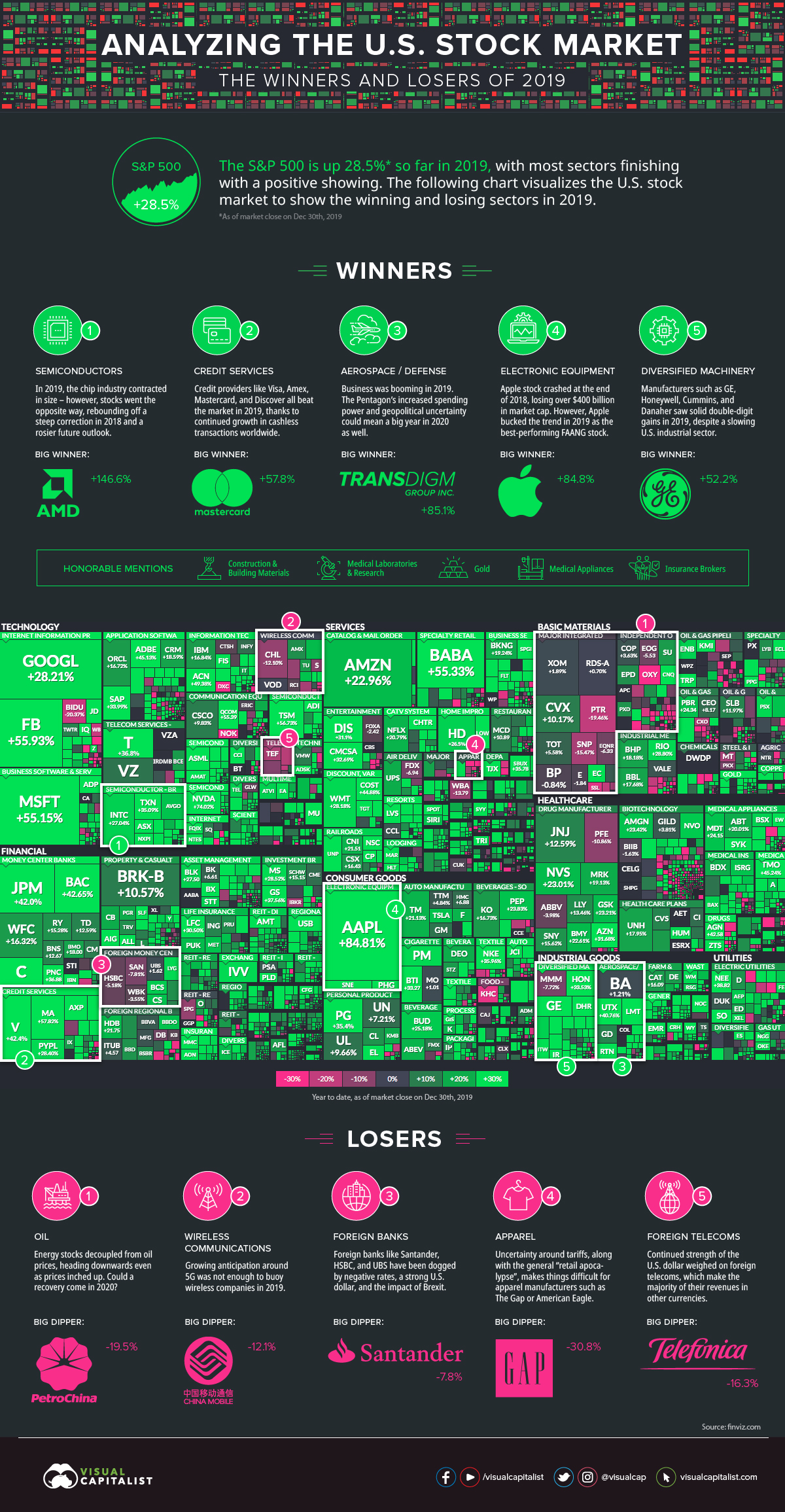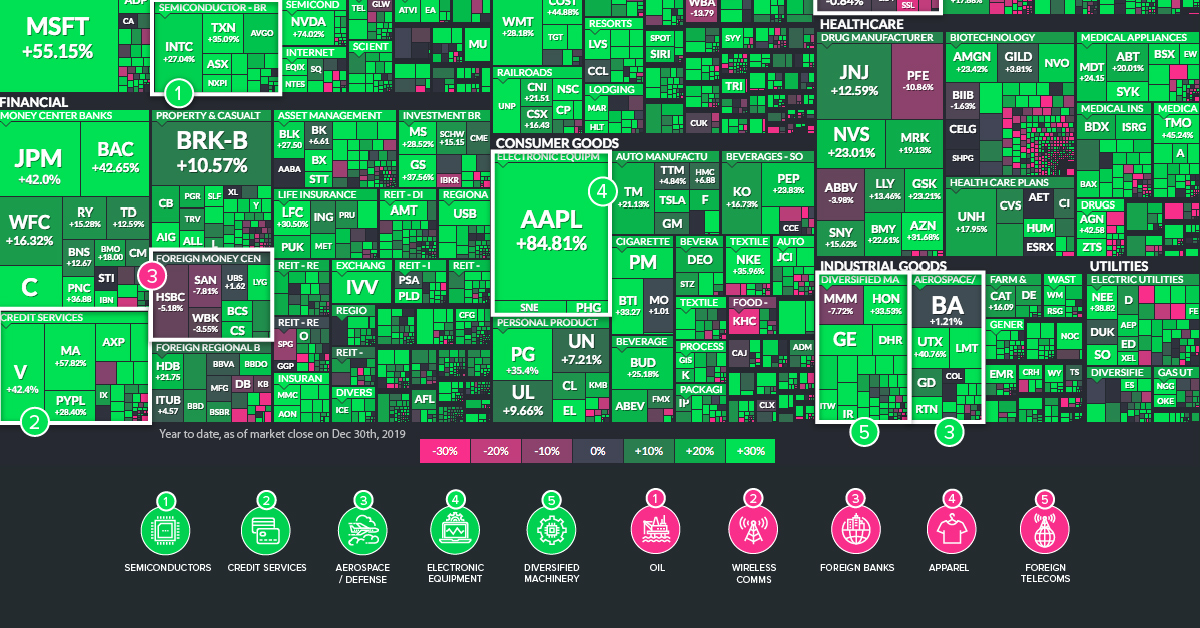Markets
The Best and Worst Performing Sectors in 2019

The Best and Worst Performing Sectors in 2019
If you think back almost 12 months, you’ll remember that the markets opened the year with extreme levels of volatility.
Stocks had just finished the worst year in a decade. Then in early January, Apple cut its earnings guidance after the company had already lost over $400 billion in market capitalization. The S&P 500 and DJIA seesawed, suggesting that the lengthy bull run could come to an end.
Yet, here we are a year later — we’re wrapping up the decade with a banner year for the S&P 500. As of the market close on December 30, 2019, stocks were up 28.5% to give the index what is expected to be its second-best performance since 1998.
Winners and Losers
Today’s infographic pulls data from Finviz.com. We’ve taken their great treemap visualization of U.S. markets and augmented it to show the sectors that beat the frothy market in 2019, as well as the ones that lagged behind.
Below, we’ll highlight instances where sectors stood out as having companies that, with few exceptions, saw ubiquitously positive or negative returns.
Top Performing Sectors
1. Semiconductors
Semiconductor stocks soared in 2019, despite sales expected to shrink 12% globally. Although this seems counterintuitive at first glance, the context helps here: in 2018, there was hefty correction in the market – and the future outlook for the industry has also been revised to be rosier.
2. Credit Services
In case you didn’t get the memo, the world is increasingly going cashless — and payments companies have been licking their lips. Mastercard, Visa, American Express, Capital One, and Discover were just some of the names that outperformed the S&P 500 in 2019.
3. Aerospace / Defense
The vast majority of companies in this market, including Lockheed Martin, Raytheon, and United Technologies, all beat the market in 2019. One notable and obvious exception to this is Boeing, a company that saw its stock get hammered after the Boeing 737 Max model was grounded in the wake of several high-profile crashes.
4. Electronic Equipment
Apple shareholders had a bit of a wild ride in 2018. The company had risen in value to $1.1 trillion, but then it subsequently lost over $400 billion in market capitalization by the end of the year. Interestingly, in 2019, the stock had a strong bounce back year: the stock increased 84.8% in value, making it the best-performing FAANG stock by far.
5. Diversified Machinery
Manufacturers such as Honeywell, General Electric, Cummins, and Danaher saw solid double-digit gains in 2019, despite a slowing U.S. industrial sector. For GE in particular, this was a bit of a comeback year after its stock was decimated in 2018.
Honorable mentions:
Construction Materials, Medical Labs & Research, Gold, Medical Appliances, Insurance Brokers
Worst Performing Sectors
1. Oil
Big oil, independent oil, and many oil services companies all had a year to forget. While this is not unusual in a highly cyclical industry, what is strange is that this happened in a year where oil prices (WTI) increased 36% for the best year since 2016.
2. Wireless Communications
Growing anticipation around 5G was not enough to buoy wireless companies in 2019.
3. Foreign Banks
It’s a tough environment for European banks right now. Not only is it late in the cycle, but banks are trying to make money in an environment with negative rates and large amounts of Brexit uncertainty. The strong U.S. dollar doesn’t help much, either.
4. Apparel
The CEO of The Gap has described U.S. tariffs as “attacks on the American consumer”, providing just another nail in the coffin to the bottom line of the retail industry. Given these additional headwinds, it’s not surprising that companies like The Gap, American Eagle, Nordstrom, Urban Outfitters, and Abercrombie & Fitch all finished the year in the red.
5. Foreign Telecoms
Continued strength of the U.S. dollar weighed on foreign telecoms, which make the majority of their revenues in other currencies.
Markets
Visualizing Global Inflation Forecasts (2024-2026)
Here are IMF forecasts for global inflation rates up to 2026, highlighting a slow descent of price pressures amid resilient global growth.

Visualizing Global Inflation Forecasts (2024-2026)
Global inflation rates are gradually descending, but progress has been slow.
Today, the big question is if inflation will decline far enough to trigger easing monetary policy. So far, the Federal Reserve has held rates for nine months amid stronger than expected core inflation, which excludes volatile energy and food prices.
Yet looking further ahead, inflation forecasts from the International Monetary Fund (IMF) suggest that inflation will decline as price pressures ease, but the path of disinflation is not without its unknown risks.
This graphic shows global inflation forecasts, based on data from the April 2024 IMF World Economic Outlook.
Get the Key Insights of the IMF’s World Economic Outlook
Want a visual breakdown of the insights from the IMF’s 2024 World Economic Outlook report?
This visual is part of a special dispatch of the key takeaways exclusively for VC+ members.
Get the full dispatch of charts by signing up to VC+.
The IMF’s Inflation Outlook
Below, we show the IMF’s latest projections for global inflation rates through to 2026:
| Year | Global Inflation Rate (%) | Advanced Economies Inflation Rate (%) | Emerging Market and Developing Economies Inflation Rate (%) |
|---|---|---|---|
| 2019 | 3.5 | 1.4 | 5.1 |
| 2020 | 3.2 | 0.7 | 5.2 |
| 2021 | 4.7 | 3.1 | 5.9 |
| 2022 | 8.7 | 7.3 | 9.8 |
| 2023 | 6.8 | 4.6 | 8.3 |
| 2024 | 5.9 | 2.6 | 8.3 |
| 2025 | 4.5 | 2.0 | 6.2 |
| 2026 | 3.7 | 2.0 | 4.9 |
After hitting a peak of 8.7% in 2022, global inflation is projected to fall to 5.9% in 2024, reflecting promising inflation trends amid resilient global growth.
While inflation has largely declined due to falling energy and goods prices, persistently high services inflation poses challenges to mitigating price pressures. In addition, the IMF highlights the potential risk of an escalating conflict in the Middle East, which could lead to energy price shocks and higher shipping costs.
These developments could negatively affect inflation scenarios and prompt central banks to adopt tighter monetary policies. Overall, by 2026, global inflation is anticipated to decline to 3.7%—still notably above the 2% target set by several major economies.
Adding to this, we can see divergences in the path of inflation between advanced and emerging economies. While affluent nations are forecast to see inflation edge closer to the 2% target by 2026, emerging economies are projected to have inflation rates reach 4.9%—falling closer to their pre-pandemic averages.
Get the Full Analysis of the IMF’s Outlook on VC+
This visual is part of an exclusive special dispatch for VC+ members which breaks down the key takeaways from the IMF’s 2024 World Economic Outlook.
For the full set of charts and analysis, sign up for VC+.
-

 Business6 days ago
Business6 days agoThe Top Private Equity Firms by Country
-

 Countries2 weeks ago
Countries2 weeks agoCountries With the Largest Happiness Gains Since 2010
-

 VC+2 weeks ago
VC+2 weeks agoVC+: Get Our Key Takeaways From the IMF’s World Economic Outlook
-

 Demographics2 weeks ago
Demographics2 weeks agoThe Countries That Have Become Sadder Since 2010
-

 Money2 weeks ago
Money2 weeks agoCharted: Who Has Savings in This Economy?
-

 Technology2 weeks ago
Technology2 weeks agoVisualizing AI Patents by Country
-

 Economy2 weeks ago
Economy2 weeks agoEconomic Growth Forecasts for G7 and BRICS Countries in 2024
-

 Wealth1 week ago
Wealth1 week agoCharted: Which City Has the Most Billionaires in 2024?













